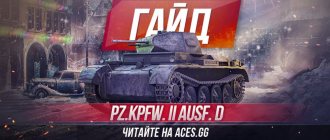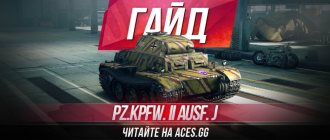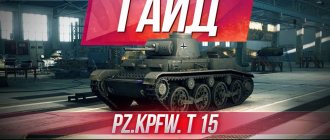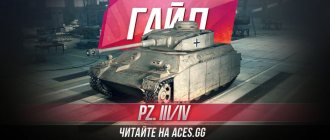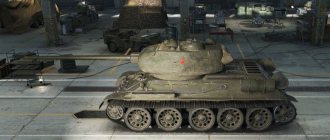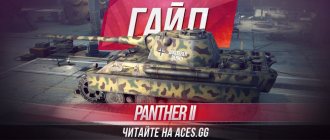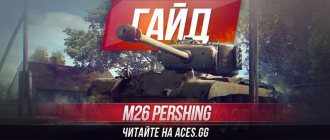Good day and welcome to aces.gg!
Friends, today our guest is a very unusual, relatively rare and very funny tank - this is the Pz. B2 guide. If you remember the full name of this vehicle, it looks like Pz. Kpfw. B2 740(f). This unit is a prominent representative of heavy tanks at the fourth level, and it belongs to the nation of Germany in the World of Tanks. Without a doubt, this vehicle can be called the king of the fourth levels for several reasons: 1.Pz. The B2 tank has excellent armor ratings among its classmates. 2. We are always balanced at the top of the list, that is, this machine has a preferential level of battles and in 100% of cases is in first place in the list of teams. Looking at the above points, I already want to call Pz. Kpfw. B2 740(f) WoT tank is an imboy, however, this heavy tank still has its weak points and first you need to understand its characteristics and other nuances.
TTX Pz. B2
Since we have already talked about the impressive armor of this vehicle, we will first of all consider these Pz. B2 characteristics. We are endowed with excellent all-round armor for our level, and the majority of the enemies we encounter experience significant difficulties in penetrating us into any projection, this applies to both the hull and the turret. Only the impressively sized commander's cupola and the driver's hatch are considered vulnerable spots. You should also be wary of some tank destroyers with their evil guns, and of course, artillery.
Now let's move on to the mobility parameters and these Pz. B2 performance characteristics are also very pleasant. We have a very good maximum speed, the engine power is enough to develop it very quickly, and everything is in perfect order with maneuverability; it is very difficult to spin this car. Otherwise, a good strength indicator will give some advantage in combination with the same armor, but the review is not enough, we will raise it.
Heavy flamethrower tank Flammwagen auf Pz.Kpfw. B2(f), Germany
Already during the first battles on the Eastern Front, the first German flamethrower tanks Pz.Kpfw.II (F) showed that their characteristics left much to be desired. The short firing range of the fire mixture, combined with insufficiently powerful armor, seriously limited the combat effectiveness of such vehicles. However, by this time, the development of a new similar armored vehicle with higher protection characteristics and firepower was already underway. The captured French-made B1bis heavy tank was chosen as the base for the new combat vehicle with flamethrower weapons. The insufficient characteristics of the existing flamethrower tank became clear even before the start of fighting on the Eastern Front. The basic light tank Pz.Kpfw.II did not have high performance, and the alteration of its design associated with the installation of new weapons had a negative impact on some parameters. So, instead of a cannon, the flamethrower tank received one rifle-caliber machine gun. In addition, it was equipped with two flamethrower nozzles, but such weapons could be used at ranges of no more than 25-30 m. As a result, the survivability of the tank on the battlefield was in doubt. Later such doubts were confirmed by practice.
In March 1941, it was decided to create a new flamethrower tank with improved protection and firepower. The captured French B1bis heavy tank was chosen as the base for such a vehicle. The armored hull of this vehicle made it possible to protect the crew and elements of the flamethrower from enemy artillery, and the existing weapon system ensured that high firepower was maintained regardless of the use of the flamethrower.
Flammwagen auf Pz.Kpfw.B2(f) flamethrower tank. Photo by Chamberlain P., Doyle H. “A Complete Guide to German Tanks and Self-Propelled Guns of the Second World War”
The order for the development of a project to modernize captured equipment was placed in March 1941. Over the next few months, the industry had to create a project and assemble a prototype of the updated armored vehicle. It was planned to begin serial assembly in November. By January 1942, it was planned to produce up to 20-25 flamethrower tanks of a new type. Several organizations were involved in the development of the project. Overall coordination of work and modernization of the base vehicle were entrusted to Daimler-Benz specialists. The development of the flamethrower and all its components was entrusted to "Kobe", and the assembly of the equipment was to be carried out.
In accordance with the designation system that existed at that time, the new project was called Flammwagen auf Panzerkampfwagen B2 (f). Also, different sources may contain other designations that reflect the type of base armored vehicle and the presence of new flamethrower weapons.
The captured tank had sufficiently high characteristics that made it possible to use it as a carrier of flamethrower weapons. The main reasons for choosing the B1bis as a base for flamethrower tanks were the armor thickness of up to 60 mm and the presence of two artillery pieces, one of which could be replaced with a flamethrower. In addition, the need to install new equipment led to some modifications to the hull design with the addition of a set of non-standard units.
The captured B1bis tank, which became the basis for the flamethrower. Photo: Wikimedia Commons
The base tank had a riveted hull, consisting of sheets up to 60 mm thick. The most powerful armor was used in the manufacture of the forehead and sides of the hull. The stern sheet had a slightly smaller thickness, 55 mm. The body was protected from above and below by parts 20-25 mm thick. A tower with protection up to 56 mm was mounted on the roof. The classic hull layout was used with artillery weapons placed in the hull. The front part of the vehicle was given over to the work stations of the driver and artillerymen who serviced the frontal gun. The fighting compartment continued in the central part of the hull, and the stern was allocated for the placement of the power plant and transmission.
The French tank was equipped with a six-cylinder Renault engine producing 307 hp. Using a transmission manufactured by Naeder, including a five-speed gearbox, the engine torque was transmitted to the drive wheels. The B1bis tank had a distinctive chassis. It consisted of 14 road wheels, assembled into several blocks with spring suspension. To improve mobility characteristics, the caterpillar was large in size and covered the side of the hull.
In its original configuration, the French heavy tank carried a 75 mm semi-automatic cannon in the front hull and a 47 mm gun in the turret. Also, two 7.5 mm machine guns were mounted next to the guns. Initially, it was assumed that the smaller caliber turret gun would be used to destroy enemy armored vehicles, and the task of the frontal gun would be to attack manpower and fortifications.
View of the stern with the fire mixture tank. Photo: Aviarmor.net
During the modernization of the new project, the base tank was supposed to receive a number of new components for one purpose or another. In addition, some parts were removed. All these changes in the design of the hull and other units were aimed at solving the main problem, which was the installation of a flamethrower.
In accordance with the new project, the flamethrower equipment was to be divided into several units distributed over different parts of the base tank. Thus, the fire hose had to be placed in the front of the vehicle, compressed air cylinders were placed inside the body, and a special external tank was developed for transporting the fire mixture.
The fire nozzle of the flamethrower had to be mounted in the front plate installation. To do this, the 75 mm cannon had to be removed from the tank and part of the front plate had to be dismantled. New parts had to be installed instead of the curved gun mantlet and the upper part of the inclined front plate. In the upper part of the forehead there was now a wheelhouse, similar to that installed at the driver’s workplace. Instead of a gun mantlet, a sheet with a cylindrical protrusion was mounted, in which the fire hose installation was mounted. Due to such modifications, in the front part of the hull it was possible to place not only a flamethrower, but also the workplace of the shooter controlling it.
The shooter had the ability to aim the flamethrower within small sectors. Horizontal guidance was provided within 10° to the right and left of the neutral position and elevation from -2° to +10°.
Flamethrower tank in the army. Photo Mg-tank.ru
Another noticeable modification affected the rear part of the hull. It was proposed to mount a complex-shaped tank on the stern plate, assembled from armor plates 30 mm thick. It was not possible to place a fire mixture tank of sufficient capacity inside the hull, which is why it was carried to the rear of the vehicle. This arrangement of the tank had some advantages. Thus, the tank body could protect the tank from fire from the front hemisphere, and if the tank was hit, the likelihood of the vehicle itself catching fire was reduced.
A pneumatic system was supposed to ensure the supply of fire mixture from the tank to the fire hose and to the target. It was proposed to mount several compressed air cylinders inside the body, used during shooting. In addition, the tank received an additional two-stroke motorcycle engine connected to a compressor to supply air to the cylinders. According to other sources, the cylinders and engine were used in various modifications of the flamethrower. According to some sources, the early version of the flamethrower was supposed to eject the fire mixture using compressed air, and the next modification received a compressor based on a gasoline engine.
The crew of the new flamethrower tank was to consist of four people. The hull housed a driver and a radio operator who controlled the flamethrower. Two more tankers were in the turret and could use a 47 mm cannon with a coaxial machine gun. All crew members had their own hatches and sets of viewing instruments.
Shooting from a flamethrower. Photo Mg-tank.ru
Alterations to the base tank led to a slight change in its dimensions. Due to the aft tank, the length of the vehicle increased to 6.86 m. The width remained at 2.5 m, height - 2.88 m. According to some reports, some of the serial flamethrower tanks were deprived of commander turrets, which was done in order to reduce the overall height of the vehicle . The use of a large tank for transporting fire mixture and other new components led to an increase in combat weight to 34 tons.
Despite the increase in weight, mobility characteristics should have remained at the same level. The maximum speed was limited to 28 km/h, the range was 150 km. The parameters of the obstacles to be overcome have remained almost unchanged.
By the fall of 1941, contractor firms had completed the development of the entire project as a whole and its individual elements in particular. After the design was completed, the first batch of Flammwagen auf Pz.Kpfw flamethrower tanks was built. B2(f) in the amount of five units. These vehicles with updated armament left the Wegmann assembly shop in November 1941.
Tests revealed a fairly high potential of the new technology. Relatively powerful armor made it possible to protect the flamethrower tank from various threats, and the 47-mm cannon in the turret provided effective self-defense or attacking targets from a fairly long range. A flamethrower installed in the front plate made it possible to throw the fire mixture at a distance of up to 40-45 m. A full tank was enough for 200 shots. The new development was approved, which made it possible to continue the modernization of captured equipment.
Tank with flamethrower removed. The units of the latter lie in front of the car. Photo: Aviarmor.net
The original plan called for five flamethrower tanks to be assembled in November 1941. In December and January, the industry was supposed to deliver 20 more machines. At the same time, however, the order noted a possible slowdown in production rates due to a lack of basic equipment. As practice has shown, the production of new tanks was indeed unable to immediately reach the required pace. In December 1941, only three captured tanks managed to be modernized. Three more vehicles were delivered in March 1942. From April to March inclusive, nine more vehicles were manufactured. Due to the Wegmann company being loaded with other orders, the assembly of Flammwagen B2(f) flamethrower tanks was transferred to French industry. Enterprises of occupied France handed over to the customer several dozen more heavy tanks with flamethrower weapons. According to various sources, in total, at least 60 French-made tanks received flamethrowers.
The new type of flamethrower tanks handed over to the troops were transferred to companies armed with basic B1bis with cannon armament. As part of such units, flamethrower B2(f) took part in various battles on different fronts. It is known about the participation of such equipment in the assault on Sevastopol and in some other operations on the Eastern Front. In addition, about half of the flamethrower tanks managed to take part in battles in Western Europe. Also, similar equipment took part in battles on the territory of Yugoslavia.
By the time the assembly of new flamethrower tanks began, the basic French-designed vehicle had become outdated. As a result, the characteristics of the Flammwagen auf Pz.Kpfw tanks. B2(f) met the requirements of the time less and less over time. However, the operation of such equipment continued for a long time. Available information about the preservation of a number of such tanks in service at the end of 1944 suggests that a few vehicles may even have survived until the end of the war in Europe.
However, the flamethrower modification of the B1bis heavy tank, for objective reasons, was unable to have a noticeable impact on the course of the war. During production, only 60 of these vehicles were built, which was extremely small for full-fledged combat use on all fronts. At the same time, within the framework of the Flammwagen auf Pz.Kpfw project. B2(f) managed to successfully solve all the assigned design tasks, as well as find a worthy use for outdated captured equipment.
Based on materials from: https://armor.kiev.ua/ https://mg-tank.ru/ https://aviarmor.net/ Chamberlain P., Doyle H. Complete reference book of German tanks and self-propelled guns of the Second World War. – M.: AST: Astrel, 2008. Ardashev A., Fedoseev S. Flame-throwing tanks and hand-held flamethrowers in battle. – M.: “Eksmo”, “Yauza”, 2013.
gun
Here it is, the holy of holies of every tank - weapons! What have the developers given us? And there’s nothing to hide here, you can see everything for yourself, Pz. The B2 gun has a very comfortable aiming time and an excellent rate of fire, but the dispersion is disappointing and you have to get used to it.
Regarding one-time damage, it, combined with the frantic rate of fire, is quite good and only armor penetration will be lacking in some cases. Therefore, carry with you 30-40 percent of gold ammunition and you will not care.
By the way, Pz. The B2 WoT tank is capable of approximately 1400 damage per minute and these numbers are simply incredible. Regarding the vertical aiming angles, -10 and +20, this is also the height of bliss, comfort is guaranteed!
Modules
| Penetration (mm) | Damage (HP) | Rapid fire (rounds/min) | Spread (m/100m) | Mixing (c) | Weight, kg) | Price (|) | ||
| II | 4.7 cm SA 35 L/34 | 55/90/24 | 52/52/62 | 27.63 | 0.39 | 1.14 | 100 | 4100 |
| Armor (mm) | Rotation (gr/sec) | Review (m) | Weight, kg) | Price (|) | ||
| II | B2-740-(f)-Turm | 46/46/46 | 43.75 | 332.5 | 2000 | 2350 |
| Power (hp) | Fire probability (%) | Weight, kg) | Price (|) | ||
| V | Renault | 340 | 20 | 400 | 19370 |
| Max. load (t) | Turning speed (gr/sec) | Rmin | Weight, kg) | Price (|) | ||
| IV | B2-740-(f)-Ketten | 33.3 | 45 | B/2 | 8050 | 1730 |
| Communication range (m) | Weight, kg) | Price (|) | ||
| VIII | FuG 8 | 525 | 50 | 20300 |
Advantages and disadvantages
More for ease of perception than for any urgent need for analysis, we will break down the strengths and weaknesses of this tank point by point, because everything is already clear.
Pros: •Excellent armor; •The most comfortable weapon in all respects; •Good mobility; •The most preferential level of battles; •The wildest DPM.
Cons: •Small review; •Vulnerable to artillery.
As you understand, the last point is already far-fetched, because this endlessly fun and strong machine really has very few weaknesses, and if you consider that in the sandbox not every enemy knows where to punch us, it becomes even more fun to play.
Equipment for Pz. B2
At a small level and the choice of equipment is small, this is no secret to anyone. We can’t even install , although with such damage per minute we don’t really need it. For these reasons, for Pz. We will choose B2 equipment from what is available and this is what we get: • – we will compensate for our small review as best we can, everything is natural. • – an unconditional choice that allows us to strengthen all our already strong sides at once. • – since we suffer quite a bit from artillery, and there is no large assortment, this module looks quite good. Many will say that this car can be equipped with , but what is the point of them if Pz. B2 tank already takes a measly 1 second?
Tactics for playing Pz. B2
Let us repeat once again that we have at our disposal a very strong heavy tank for its level. We have excellent armor, a very comfortable weapon and reasonable mobility, and therefore our place is on the first line.
At the same time, on Pz. B2 combat tactics do not consist of a stupid rush; nevertheless, there will be tank destroyers in the enemy team that can cool our ardor, and even after charging gold, some opponents will be able to penetrate us without much difficulty. For this reason, you should not fight with a large number of enemies at the same time; first, you should be careful and shoot from cover, dancing and hiding most of the body.
An excellent technique is to easily rotate the body and place the Pz. B2 World of Tanks with a diamond, because then our armor becomes even more formidable. Otherwise, try to look at the mini-map, support your allies in different directions and get as much pleasure from bending as possible.
To summarize, I will say that if you ever have such an opportunity, Wargaming will organize a promotion and so on, Pz. B2 is worth buying, this tank is very comfortable to play and relax your soul.
PzKpfw B2 740 (f) in the game
Combat effectiveness
Pros of the tank:
- Equally strong armor (the same on all sides, only 5 mm less in the stern).
- A fast-firing and fairly accurate gun.
- High rotation speed of the turret and the tank itself.
- Good balance - the tank is always at the top.
- Large ammunition capacity.
- Not bad acceleration dynamics.
- Cheap repairs and maintenance.
- An excellent profit for a tank of its level.
Flaws:
- A weapon with weak damage and armor penetration.
- A single-man turret, the incapacitation of the commander has catastrophic consequences.
- Low speed.
- Expensive but popular modules are lining and ventilation.
- An extremely specific distribution of roles in a tank, limiting its capabilities as a simulator.
- The turret is less armored than the hull; if it is hit by an SPG shell, damage to the gun is almost guaranteed.
Level 4 - our main rivals:
General rules - it is better not to attack them alone, shoot from cover or ambush, go to the flank or rear.
- The T-28 is a dangerous enemy if armed with an F-30 or ZiS-4. However, it is too good a target with too little armor. Nevertheless, it is dangerous to enter into a 1 on 1 battle; it is better to shoot from an ambush. Fortunately, the tank is passable up to KV - this noticeably reduces the combat qualities of the T-28 due to the poor training of the crew (training them costs a little less than buying a tank) and the crooked hands of the owner.
- The M3 Lee is potentially dangerous, but the skills of its owners are usually even lower than those of the T-28 owners - the atypical specifics of its use are superimposed on the through nature of the vehicle. We knock down the caterpillar and shoot it at the side/stern. If it is impossible to shoot down the track or enter from the side, we shoot at the lower armor plate, the driver's viewing slot or at the commander's turret.
- PzKpfw III is deadly in a head-to-head fight (its forehead is not penetrated by us, but ours is completely), so we shoot at the lower armor plate and pray, and you can also shoot at the hatch on the turret. When performing a carousel, it is perfectly shot at vulnerable sides.
- A-20 and M5 Stuart - unlike Leo, they make their way everywhere. The rest is similar to Leopard.
- SU-85B and Hetzer - both PTs have powerful guns, and the German also has an impenetrable forehead. It is better to attack both vehicles in company, or, as a last resort, to board them. This tactic is especially good against the German - he has a view of only 300 m, and the sides are vulnerable. The passing character of these cars also adds to the chances.
- PzKpfw B2 740(f) - due to low armor penetration, it is almost impossible to penetrate the front and side. You need to shoot at the turret - it penetrates everywhere except the gun mantlet. At close range you can penetrate the commander's turret. Also, you can shoot at the welded mask from the howitzer and at the viewing slit of the mechanical drive.
- Valentine - low armor penetration does not allow you to penetrate the forehead of this tank. However, the engine compartment is more vulnerable; when shooting at the engine, penetration is almost guaranteed. Every other time, the gun mask and observation devices above the driver’s position break through.
- The T40 is an American tank destroyer, reminiscent of the Marder in its visibility and gun aiming angles. However, unlike the German self-propelled gun, it has fairly good frontal armor, which is also prone to ricochet. However, even in a head-on firefight there is a chance to win - the armor directly in the area of the gun is successfully penetrated even by Valentine’s weak gun, and there is also a chance to disable the gun.
- AMX 40 is a French light tank. In a clinch, aim at the machine-gun turret or the mechanical drive slot under the turret; if you come from behind, shoot at the “gills” covering the engine. This tank is a very dangerous enemy - its gun, although inaccurate and rather slow, penetrates the B2 quite confidently without targeting weak points.
- B1 - very similar to Pz B2. But the Frenchman has many more weak points in his armor: the commander’s cupola is the main weak point of the B1, and the 75-mm gun installed in the hull is also the weak point of the tank. Oddly enough, but the penetration zones are located directly on the tracks protruding from the front. The howitzer's mask is even more vulnerable than that of the B2. On the other hand, the top gun SA 37 allows (although not always guaranteed) to penetrate both B1 and B2 without targeting weak points, it is enough to shoot at a right angle.
Of the tier 3 artillery self-propelled guns, the most dangerous is the rapid-firing and accurate SU-26, which is also quite popular because of this among skilled players. Theoretically, the others should also pose a threat, but the Wespe and M37 have problems with accuracy and rate of fire, and the Sturmpanzer II has problems with aiming angles. Again, let’s not forget about the poor training of the majority of the crews of these vehicles - few newbies can afford large expenses for crew training. However, it is unsafe to attack several of these vehicles alone at once - the firepower of the tank cannot ensure their rapid destruction, and the danger of return fire increases due to the large dimensions of the B2, it is difficult to miss it. Among Tier 3 tank destroyers, Marder II can be considered the most dangerous. However, in capable hands, the Marder is dangerous for any tier 3-5 vehicle due to its excellent visibility and large gun aiming angles. In addition, the frontal armor can ricochet and cannot be penetrated by small-caliber guns. T82 and SU-76 are less dangerous: the first - due to very weak armor, the second - due to very small aiming angles and the almost complete absence of any skilled players on this tank destroyer (many prefer to immediately open the SU-85 through T -34).
Level 2 - cannon fodder:
Tier 2 tank destroyers and artillery self-propelled guns are low-dangerous: the Panzerjager lacks armor penetration to guarantee penetration, and the AT-1 lacks visibility. But the T18 can cause some trouble with its fast-firing and penetrating two-pound cannon, as well as its thick forehead - so it is better to use the significant advantage in visibility and, if possible, fire at the less armored sides and stern. Theoretically, the Bison (like the SU-18 and T57) can create problems in the right hands, but there are very few skilled players in low-level vehicles.
